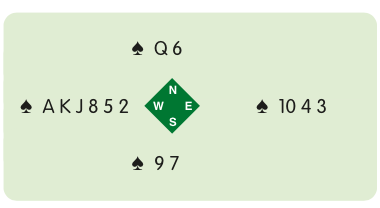Defensive signal whereby the play of the cards in one suit indicates a preference between two other suits.
The principle is that a high card asks for a high suit, a low card for a low suit. It is most common to give a suit- preference signal when you believe that partner will not wish to play the suit in which you are giving the signal, such as when you are giving partner a ruff.

West leads the two of spades against a heart contract, clearly a singleton. After winning with the ace, East returns a high spade (the nine) to ask for the higher-ranking of the other side suits (diamonds) or the two to ask for the lower-ranking suit (clubs).
Some pairs, by agreement, play suit- preference discards, usually known as McKenney discards. Tournament players and the top rubber bridge players use suit-preference signals in further situations, such as when following to the second round of a suit having already given a count or attitude signal on the first round.

West cashes his top spades against
a heart contract. On the first round, East must play low (the three) so that West can work out who has the doubleton. On the second round, East has a choice. The ten, the higher card, suggests a diamond switch, while the four, the lower card, suggests a club switch.

